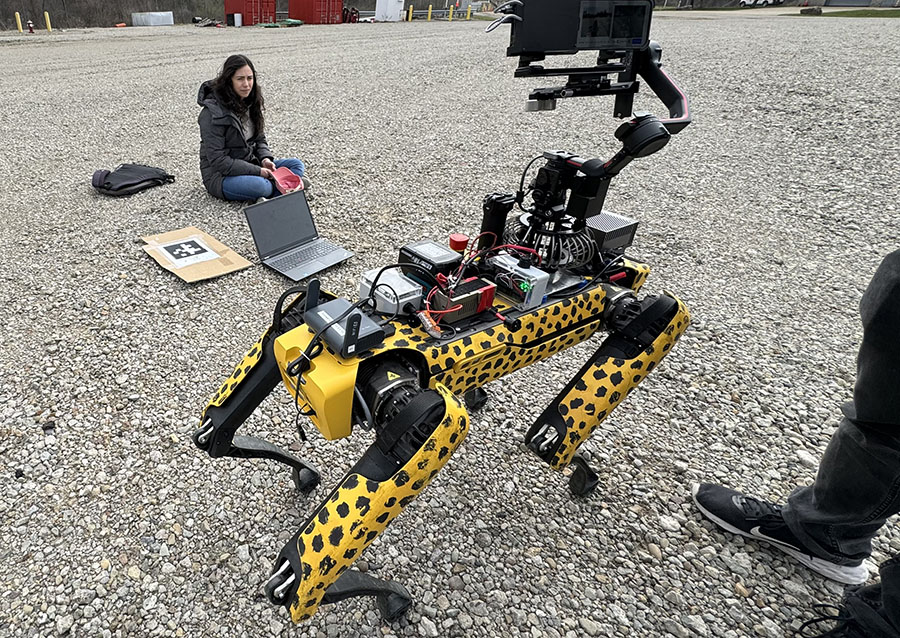CMU, Pitt Researchers Compete in Three-Year, $7M DARPA Triage Challenge Team Chiron To Use Robotics, AI, Sensors To Detect Severe Injuries in Mass Casualty Events
Marylee WilliamsTuesday, August 6, 2024Print this page.

Every second matters to emergency medical teams as they approach a mass casualty event and identify who needs immediate treatment. Breakthroughs in medical triage using robotics, artificial intelligence, drones and advanced sensing could save lives by directing medical personnel to people most in need of treatment.
Team Chiron hopes to make those breakthroughs happen.
The team, comprising researchers from Carnegie Mellon University and the University of Pittsburgh, is developing noninvasive, remote-detection systems for injury assessment as part of the Defense Advanced Research Projects Agency's (DARPA) three-year, $7 million DARPA Triage Challenge. Team Chiron will use an aerial drone and several ground robots equipped with multimodal sensor packs to evaluate the severity of injuries on mannequins and human actors.
"A critical outcome of this challenge is to infer lifesaving interventions from injury patterns and globally integrate that data with responders for transportation and sustainment response execution," said Kimberly Elenberg, the team's principal investigator and a principal project scientist in the Robotics Institute (RI) in CMU's School of Computer Science.
DARPA is hosting the challenge to push advancements in medical triage. Teams from across the world are building robotic systems that can detect injuries in a mass casualty event and determine their severity using data captured by sensors on autonomous systems. The teams will be scored on the percentage of casualties identified, the accuracy in reporting casualty locations and casualty injury classification, the time to complete these casualty assessments, and more.
The DARPA Triage Challenge consists of three rounds of competition in three categories: systems, virtual or data. Team Chiron is one of 15 teams competing in the systems category. The first-place team in the final round of competition in the systems category will win $1.5 million. Millions more in prize money and funding will be awarded to teams during the three-year challenge.
Team Chiron tested their robotic system in June to gather data and prepare for the challenge's first competition in late September. During the test, robots and drones performed tasks assessing the medical status of casualties in a simulated environment. They measured vital signs such as heart and respiratory rate, and used thermal cameras to detect body heat. The team tested network reliability through the transmission of data to DARPA's central command unit. Overall, these tests aimed to improve the efficiency, accuracy and reliability of medical triage and disaster response.
In the first competition, members of the team will control aerial and ground robots that survey the scene of a mass casualty event. In the second- and third-year challenges, the robots must act autonomously. Throughout the competition, Team Chiron will benefit from CMU's prior participation in the DARPA Subterranean Challenge, where CMU made autonomous robots that mapped and searched underground environments such as mines, cave networks and urban infrastructure, said John Galeotti, a senior systems scientist in the RI.
"Right now, we're focused on how to use sensors and AI to estimate these physiological signs of trauma in a noncontact way," Galeotti said. "Normally, if a field medic, an EMT or a nurse were there, some of the first things they would do is walk up to the patient and take their pulse, touching them. There are a lot of things they would do that are hands-on. We can't do any of that.
"One of the biggest parts of this challenge is how we decide what state the casualties are in when we can't get any closer than a meter away," he continued. "We and the other teams are focusing heavily on that problem in year one, and there is still a lot to be done."
Each team is tackling research questions about how to best use robotics, AI and other technologies to assess and identify the severity of injuries. At the end of the three-year competition, Galeotti said, researchers will know how to better tackle the problems of medical triage.
"Whether or not we've solved all the problems, we will hopefully have proven technologies that can solve several of the problems," he said. "We're hopeful that, as a tangible outcome of this competition, we begin to see the transition of the technologies out of academia into commercially available products that ultimately play a role in saving people's lives.
Along with Elenberg and Galeotti, RI members of Team Chiron include Sebastian Scherer, an associate research professor; Artur Dubrawski, the Alumni Research Professor of Computer Science; Laszlo Jeni, an assistant research professor; and Srinivasa Narasimhan, the U.A. and Helen Whitaker Professor of Robotics. The team also includes Dr. Leonard Weiss, an associate professor in the Emergency Medicine Department at the Pitt School of Medicine.
To learn more about Team Chiron, its sponsors and partners, and how to get involved, visit their website.
Aaron Aupperlee | 412-268-9068 | aaupperlee@cmu.edu
